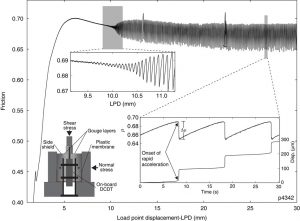
Up until now catching lightning in a bottle has been easier than reproducing a range of earthquakes in the laboratory, according to a team of seismologists who can now duplicate the range of fault slip modes found during earthquakes, quiet periods and slow earthquakes.
“We were never able to make slow stick slip happen in the laboratory,” said Christopher Marone, professor of geosciences, Penn State. “Our ability to systematically control stick velocity starts with this paper.”
The research, led by John Leeman, Ph.D. candidate in geoscience and including Marone, Demian Saffer, professor of geosciences at Penn State and Marco Scuderi, a former Ph.D. student in geosciences now at Sapienza Università di Roma, Italy, recreated the forces and motion required to generate slow earthquakes in the laboratory using ground quartz and a machine that can apply pressure on the materials altering stresses and other parameters to understand frictional processes.
“While regular earthquakes are catastrophic events with rupture velocities governed by elastic wave speed, the processes that underlie slow fault slip phenomena, including recent discoveries of tremor, slow-slip and low-frequency earthquakes, are less understood,” the researchers report in Nature Communications.
Catastrophic earthquakes, the kind that destroy buildings and send people scurrying for doorways and safe locations, are caused when two tectonic plates that are sliding in opposite directions stick and then slip suddenly, releasing a large amount of energy, creating tremors and sometimes causing destruction. Along regions of faults that do not produce earthquakes, the two sides of the fault slowly slip past each other in a stable fashion. Slow earthquakes occur somewhere between the stable regime and fast stick slip.
Regular earthquakes take place rapidly, while slow earthquakes occur on time scales that may range up to months. They can be as large as magnitude 7 or more and may be precursors to regular earthquakes. However, slow earthquakes propagate slowly and do not produce high-frequency seismic energy. They exist in the regime between stable slipping and regular earthquakes.
The researchers applied stress perpendicular to the direction of shear and then applied forces to shear the ground quartz. By altering the amount of stress placed in the perpendicular direction, they could achieve the audible crack of a regular earthquake, stable slippage and a wide range of slip-stick behaviors including slow earthquake.
“What’s really cool about this is that nobody has been able to systematically produce a slow earthquake, stable sticking, the whole range between a slow and fast earthquake,” said Marone.
Reference:
J. R. Leeman, D. M. Saffer, M. M. Scuderi, C. Marone. Laboratory observations of slow earthquakes and the spectrum of tectonic fault slip modes. Nature Communications, 2016; 7: 11104 DOI: 10.1038/ncomms11104
Note: The above post is reprinted from materials provided by Penn State. The original item was written by A’ndrea Elyse Messer.










